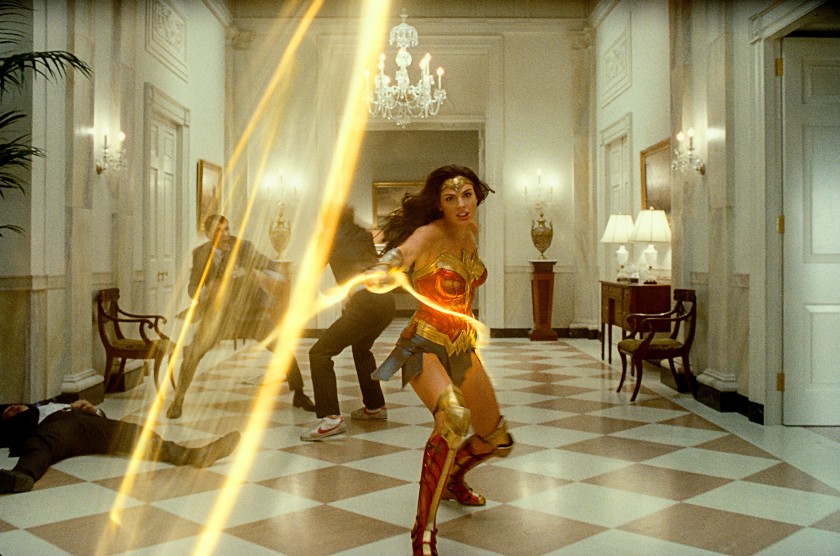What a difference a year makes. In December 2019, the box office was gearing up for Oscar hopefuls such as 1917, Little Women, Bombshell, and Richard Jewell. While also welcoming big sequels like Jumanji: The Next Level and Star Wars: The Rise of Skywalker. (Even Cats, for some). In a year of changes because of the ongoing COVID-19 pandemic, the holiday box office season has all but been abandoned. That can be said for most of 2020 – big films such as F9: The Last Saga and A Quiet Place: Part II have retreated into a crowded 2021 release schedule.
With No Time To Die making a move off of the November/December schedule first, all eyes were on Wonder Woman 84. A huge tent pole release for Warner Brothers, this movie has already seen its release date moved quite a bit (its original release date was originally December 19th, 2019). Warner Brothers had a choice to make. As COVID-19 cases surge throughout the country, the viability of seeing WW 84 becomes less and less. Having a similar situation with Christopher Nolan’s Tenet earlier in the summer, it’s $356 million box office gross, while ok for the current time, is less than intended. Although you have to think, they will recoup some of that with the home release of the film in a couple of weeks.
So, there’s a compromise – Wonder Woman 84 will release both on Warner-affiliated streaming service HBO Max and whatever theaters are open for Christmas Day. Setting the movie up with a head-to-head battle with Pixar’s Soul that will be released on Disney +. Max can use the boost in subscriber count, as the service trails both the likes of Disney + and Netflix. A movie like Wonder Woman 84 can be a nice bridge into the much anticipated Zack Snyder’s Justice League due for release on the service next year. With a return to theaters still in flux, the change in viewing habits of the mass populace, and a 2021 movie slate that is still trying to find its footing, is the hybrid release of WW84 a glimpse into the future?
Now, we’ve seen these iterations of these releases this past year. Universal Pictures decided to release Trolls World Tour as both a theater and $19.99 PVOD release at the height of the first wave of the pandemic back in April. The gamble paid off as the studio made almost $100 million from that decision alone. Warner Bros did this with Scoob!, where it quickly rose to number one on the PVOD chart. Just think of how much a trip to the movie theater would cost a family of four – tickets, food, and drinks run a considerable fee. Now families have options to watch these films within their own homes.
Would this approach work with a bigger budgeted film? Disney elected to put Mulan on its streaming service for a $30 PVOD price while releasing in theaters overseas. While it didn’t do well at the box office, about 18% of new Disney+ subscriptions bought the movie and it kept 21% of previous subscribers on the service. As the year went on, many movie fans were looking for the next shoe to drop. Bigger films got out of dodge, but what was going to be the one to take the plunge? Was it going to be Black Widow or maybe a horror release such as Spiral? There is a lot at stake on Christmas Day as a considerable uptick in HBO Max’s interest could alter release strategies for good. It may be financially viable for Judd Apatow‘s The King of Staten Island to get released straight to PVOD, but will this work for a perceived blockbuster?
Regardless of the eventual when we all go back to the theaters and bask in the experience, the prominence of streaming is here to stay. Netflix has spent millions upon millions of dollars in producing films within its own library. Hulu and Amazon Prime have been willing to spend money to get films due for bigger releases on their services. Disney shifted its focus to streaming, making more content that just focused on its direct-to-consumer base. Universal has reached agreements to shorten the release window with theaters.
News of COVID-19 vaccines has brought good news, but it’s going to take a considerable amount of time to get them out to mass quantities of people. The winds of change are here, and when the dust settles, theater chains will have to entice people back into their recliner chairs. Think of Avengers: Endgame – nothing beats sharing that experience with a bunch of enthusiastic fans. However, who can even fathom sitting in a crowded theater with the risk at this point? In a year that has altered our way of life for the considerable future, it may also change the way we consume film.













